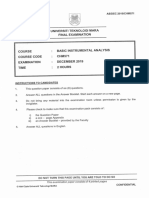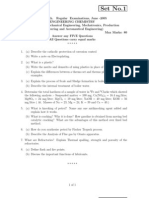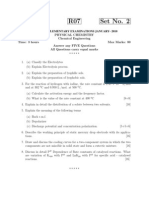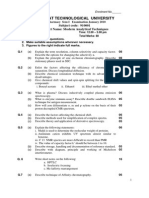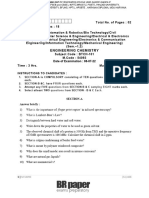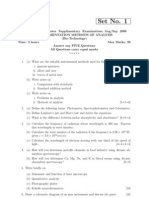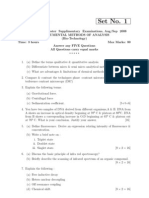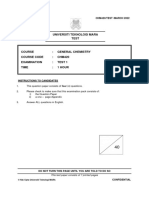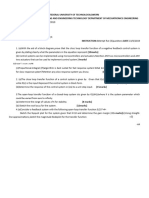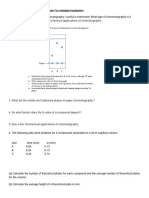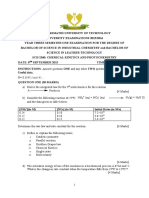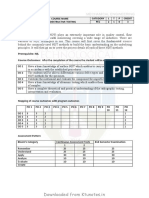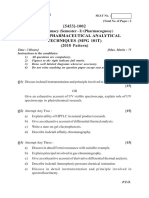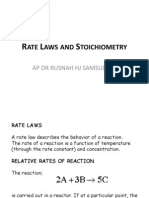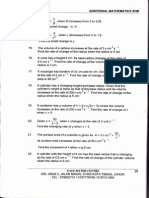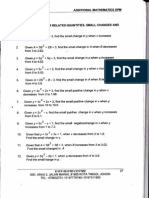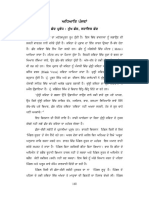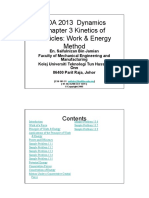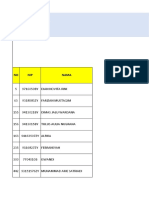CHM580
CHM580
Uploaded by
Azreen AnisCopyright:
Available Formats
CHM580
CHM580
Uploaded by
Azreen AnisOriginal Title
Copyright
Available Formats
Share this document
Did you find this document useful?
Is this content inappropriate?
Copyright:
Available Formats
CHM580
CHM580
Uploaded by
Azreen AnisCopyright:
Available Formats
CONFIDENTIAL
AS/APR 2010/CHM580
UNIVERSITI TEKNOLOGI MARA FINAL EXAMINATION
COURSE COURSE CODE EXAMINATION TIME
SPECTROCHEMICAL METHODS OF ANALYSIS CHM580 APRIL 2010 3 HOURS
INSTRUCTIONS TO CANDIDATES 1. 2. 3. This question paper consists of six (6) questions. Answer ALL questions in the Answer Booklet. Start each answer on a new page. Do not bring any material into the examination room unless permission is given by the invigilator. Please check to make sure that this examination pack consists of: i) ii) iii) the Question Paper a four - page Appendix - provided by the Faculty an Answer Booklet - provided by the Faculty
DO NOT TURN THIS PAGE UNTIL YOU ARE TOLD TO DO SO
This examination paper consists of 7 printed pages
Hak Cipta Universiti Teknologi MARA
CONFIDENTIAL
CONFIDENTIAL
AS/APR 2010/CHM580
QUESTION 1 a) Calculate the frequency, the wave number and the energy associated with the 5.715 urn vibrational absorption band of an aliphatic ketone. (2 marks) Explain why the transmitted radiation, P, is always less than the radiation, P0, incident onto a cuvette, even if there is no absorption of radiation by the contents of the cuvette. (2 marks) Compare the following i) hydrogen and deuterium lamps. (1 mark) ii) conventional and diode array spectrophotometers. (2 marks) d) A monochromator is one of the components of an optical instrument. i) What is the function of a monochromator? (1 mark) ii) Explain why a monochromator is the best choice in an optical instrument to be used for the function mentioned in (i) above. (2 marks) e) Deviations from Beer's Law become noticeable at high concentrations of samples. i) How would the absorbance-concentration plot deviate from Beer's Law at high concentrations and why does this deviation occur? (2 marks)
b)
c)
ii) If you were analyzing a relatively concentrated solution, what can you do to bring the absorbance level into the linear Beer's Law range without changing the concentration of solution? Justify your answer. (2 marks)
Hak Cipta Universiti Teknologi MARA
CONFIDENTIAL
CONFIDENTIAL
AS/APR 2010/CHM580
QUESTION 2 a) Flame and electrothermal vaporizer are atomizers for atomic absorption spectroscopy (AAS). i) Compare the signal produced from flame atomic absorption spectroscopy (AAS) to electrothermal AAS. (3 marks) ii) Which technique in a (i) is expected to have a lower detection limit? Explain. (3 marks) iii) Give one other advantage and disadvantage of each method. (2 marks) b) Describe the basic principles and requirements of a hollow cathode lamp in AAS and a plasma in inductively coupled plasma (ICP), (4 marks)
c) Spectral and chemical interferences are encountered in atomic absorption methods i) Describe the two types of interference. (3 marks) ii) Give two examples of chemical interference. (2 marks) iii) Name one method that could be used to correct for each of these interferences in part d ii) and describe how each method works to correct for the corresponding interference. (4 marks) d) A gas is flowed through the graphite furnace during operation. Name the gas used for the purpose. Does this flow occur during all three step processes in the electrothermal cycle? If not, specify which steps and explain. (3 marks) e) Describe two reasons why an ICP torch is better than a flame for multi-element emission. (4 marks)
Hak Cipta Universiti Teknologi MARA
CONFIDENTIAL
CONFIDENTIAL
AS/APR 2010/CHM580
f)
Analysis by flame AAS was conducted on an archeological sample consisting of pottery fragment for cadmium. The 2.2319 g shard sample was digested by addition of 2 mL of 40% HF and 2 mL of 65% HN0 3 . This sample was then diluted to 25.00 mL with deionized water. Aliquots of 1.0 mL of treated sample were added to five 10.0 mL volumetric flasks. The following volumes of 200 ppm Cd(N0 3 ) 2 standard solution were added followed by dilution to the 10.0 mL mark. The flame AA signal were measured for each and summarized below. Volume of standard solution (mL) 0 1 2 3 4 Signal 0.156 0.272 0.397 0.511 0.626
A plot of absorbance against volume of added standard produced a linear relationship, y = 0.1179x +0.1566. Calculate the percentage of Cd in the pottery fragment. (4 marks)
QUESTION 3 a) The structures of the principal male and female sex hormones, testosterone and estradiol are shown below. Ultraviolet-visible (UVA/is) spectrometer is used to determine the concentration of the hormones. OH OH
Hcr
Testosterone
Estradiol
i) Explain the principles of UVA/is absorption by these molecules. (3 marks) ii) What are the transitions for the UVA/is absorption of testosterone? (2 marks) b) Explain how infrared (IR) spectroscopy is useful in identifying the molecular structure and the limitations for its use in structure elucidation. (4 marks)
Hak Cipta Universiti Teknologi MARA
CONFIDENTIAL
CONFIDENTIAL
AS/APR 2010/CHM580
c)
Distinguish between Stokes and anti-Stokes lines. Why are anti-Stokes lines less intense than Stokes lines? (4 marks)
d) Why is spectrofluorometry potentially more sensitive than spectrophotometry? (3 marks)
QUESTION 4 a) In nuclear magnetic resonance (NMR) spectroscopy, define and illustrate the chemical shift parameter. (3 marks) The 1H chemical shift of ethylene at 8 5.27 is at about the middle of the proton chemical shift range. Indicate, relative to ethylene, approximately where the following proton types would resonate i) A proton which is more shielded relative to ethylene. (2 marks) ii) A proton which is down field from ethylene. (2 marks) iii) A proton that is on a carbon with more s character. (2 marks) c) Indicate how many nonequivalent peaks can be observed in the 13C NMR spectrum of each compound in the following set:
b)
(6 marks)
Hak Cipta Universiti Teknologi MARA
CONFIDENTIAL
CONFIDENTIAL
AS/APR 2010/CHM580
QUESTION 5 State the advantages of a) FT-NMR measurement over a continuous wave (CW) measurement in NMR spectroscopy. (3 marks) Electron impact (El) over Field Ionization (Fl) or Chemical Ionization (CI) sources in mass spectrometry. (3 marks) Describe two applications of MS or GC-MS or NMR technology in Magnetic Resonance Imaging in either forensic science, environmental analysis or clinical applications. (2 marks)
b)
c)
QUESTION 6 Compound D has the formula C9H120. The 13C NMR spectrum shows peaks at 28, 31 57, 122 124, 125 and 139 ppm. The IR and NMR spectra are shown below. a) Calculate the index of hydrogen deficiency for the compound. (2 marks) b) What functional groups do the index and IR spectrum indicate? (2 marks) c) What is the ratio of protons as you go from upfield to downfield in the 1H NMR spectrum and what information does it give? (3 marks) What does the 13C NMR indicate? (3 marks) e) Determine the structure of the Compound D. (5 marks)
d)
Hak Cipta Universiti Teknologi MARA
CONFIDENTIAL
CONFIDENTIAL
AS/APR 2010/CHM580
MELT 25 26
- -
17
5.5
10
12
13
14
WCOLET305XFT4R 15 16 17 18 19 21 22 _^J.J..
I T H JL-- _ _ .
N . ,
a ' "
1 _
\TA \ TTl
ru
\ ,
/^
7
\ \
4^P -\ h
' /
l
-i- ^ , f !tl I-I- \JJ iL s IS _Iii 4-L." J
" -
W V
j4iT-
hi"' i f j - ...A BJ. 1 "
\ IJ
A-
5 * 0 ' "B"i "A-f -4 6 - 0.6 ; o.e : 0.9
T-H 1
_._i-!_
_ -
ii.
w
1600 1400 1200 1000
. i ?ft
4000
3800
3600
3400
3200
3000
2*00
2600
2400
2200
2000
1600
JLJ r
(ppm)
< 1 1 1 1 1 1 < i
ui
1*
jJU
U
(nun)
END OF QUESTION PAPER
Hak Cipta Universiti Teknologi MARA
CONFIDENTIAL
You might also like
- COMSATS University Islamabad, Lahore Campus: Assignment 1 - Chemical Reaction Engineering SP-2021Document1 pageCOMSATS University Islamabad, Lahore Campus: Assignment 1 - Chemical Reaction Engineering SP-2021Samaha FatimaNo ratings yet
- CHM580Document8 pagesCHM580Azreen AnisNo ratings yet
- Course Course Code Examination Time Spectrochemical Methods of Analysis CHM580 JUNE 2012 2 HoursDocument9 pagesCourse Course Code Examination Time Spectrochemical Methods of Analysis CHM580 JUNE 2012 2 HoursNur CichimaNo ratings yet
- CHM580Document8 pagesCHM580Azreen AnisNo ratings yet
- Final Theory Exam-307 June2012Document13 pagesFinal Theory Exam-307 June2012Jagadeesh EllilNo ratings yet
- Universiti Teknologi Mara Final Examination: Confidential EH/OCT 2012/CHE335/393Document7 pagesUniversiti Teknologi Mara Final Examination: Confidential EH/OCT 2012/CHE335/393Faradilah Binti Ajma'inNo ratings yet
- Feb. 2022 Ptu PaperDocument2 pagesFeb. 2022 Ptu Paperthakralshivam21No ratings yet
- April 2010Document304 pagesApril 2010Jagdish Hire100% (1)
- CHM571-1.PDFDocument5 pagesCHM571-1.PDF2022841642No ratings yet
- Semester - 3: Chemical EngineeringDocument135 pagesSemester - 3: Chemical EngineeringKevinNo ratings yet
- Universiti Teknologi Mara Final Examination: Confidential EH/JAN 2013/CHE515Document8 pagesUniversiti Teknologi Mara Final Examination: Confidential EH/JAN 2013/CHE515sehagendutNo ratings yet
- Engineering Chemistry 2019 Scheme SyllabusDocument9 pagesEngineering Chemistry 2019 Scheme SyllabusAfsal Sha MNo ratings yet
- Engineering ChemistryDocument9 pagesEngineering ChemistryAnuj EsthapanoseNo ratings yet
- CHM626 NOV2023 TEST 1 QuestionsDocument5 pagesCHM626 NOV2023 TEST 1 QuestionsNUJMATUL HUDA AHARUL HADAFINo ratings yet
- Engineering ChemistryDocument5 pagesEngineering Chemistryapi-26349602No ratings yet
- CHM626 NOV2023 TEST 1 AnswersDocument7 pagesCHM626 NOV2023 TEST 1 AnswersNUJMATUL HUDA AHARUL HADAFINo ratings yet
- MSC Chemistry Oct2011Document186 pagesMSC Chemistry Oct2011KoNi ChiWaNo ratings yet
- Engineering Chemistry: Inst Ruct Ions T O Candidat EsDocument2 pagesEngineering Chemistry: Inst Ruct Ions T O Candidat EsJaskaran SinghNo ratings yet
- Chem 315 Practice QuizzesDocument9 pagesChem 315 Practice QuizzesLuke HarrisNo ratings yet
- UCB001Document1 pageUCB001Samaksh GulatiNo ratings yet
- IMA Questions PaperDocument17 pagesIMA Questions PaperAj Shinde100% (1)
- UCB008Document2 pagesUCB008ishuNo ratings yet
- Chemistry JuneDocument3 pagesChemistry JuneManjit kaur RandhawaNo ratings yet
- 07a1bs08 Physical ChemistryDocument4 pages07a1bs08 Physical ChemistrySRINIVASA RAO GANTANo ratings yet
- Chemistry QnsDocument3 pagesChemistry QnsAleem MuhammadNo ratings yet
- (WWW - Entrance-Exam - Net) - Gujarat Technological University M.pharm 1st Sem Modern Analytical Techniques Sample Paper 3Document2 pages(WWW - Entrance-Exam - Net) - Gujarat Technological University M.pharm 1st Sem Modern Analytical Techniques Sample Paper 3mattyg35No ratings yet
- CU-2022 B.Sc. (Honours) Chemistry Semester-6 Paper-DSE-A-4 QPDocument2 pagesCU-2022 B.Sc. (Honours) Chemistry Semester-6 Paper-DSE-A-4 QPsanchita MannaNo ratings yet
- Chemistry Pyq'sDocument13 pagesChemistry Pyq'sHarshitNo ratings yet
- rr222304 Instrumentation Methods of AnalysisDocument6 pagesrr222304 Instrumentation Methods of AnalysisSRINIVASA RAO GANTANo ratings yet
- r05222302 Instrumental Methods of AnalysisDocument6 pagesr05222302 Instrumental Methods of AnalysisSRINIVASA RAO GANTANo ratings yet
- WS2019 2020Document6 pagesWS2019 2020ayisha.maharramovaNo ratings yet
- Question Bank of Chemistry (BSC-105) For 2018 Onwards Batch StudentsDocument8 pagesQuestion Bank of Chemistry (BSC-105) For 2018 Onwards Batch Studentsinterestingfacts2525No ratings yet
- General Chemistry QuestionsDocument3 pagesGeneral Chemistry QuestionsSagar JainNo ratings yet
- NTU - Mechanical Engineering - MP 4004 - Advanced Manufacturing and Nanotech - Sem 1 07-08Document6 pagesNTU - Mechanical Engineering - MP 4004 - Advanced Manufacturing and Nanotech - Sem 1 07-08awy02No ratings yet
- Spectroscopic TechniquesDocument2 pagesSpectroscopic TechniquesMuteti ShadrackNo ratings yet
- TEST 1 Mac - QDocument6 pagesTEST 1 Mac - QAizat AshrafNo ratings yet
- Btech 1 Sem Applied Chemistry Pacia101 2018 PDFDocument2 pagesBtech 1 Sem Applied Chemistry Pacia101 2018 PDFNew.T.O.N SethiNo ratings yet
- S2 Assign2 QnsDocument8 pagesS2 Assign2 QnsFiona OyatsiNo ratings yet
- Wa19Document14 pagesWa19michaelchimuanya659No ratings yet
- Suggested Answer - Tutorial 2 Chm510Document6 pagesSuggested Answer - Tutorial 2 Chm510Mark SullivanNo ratings yet
- TUT 1 Introduction To ChromatographyDocument3 pagesTUT 1 Introduction To Chromatographysikho0ndevuNo ratings yet
- 10 - SOT Question Paper End Sem 2012Document2 pages10 - SOT Question Paper End Sem 2012Harsh ThakurNo ratings yet
- Universiti Teknologi Mara Final Examination: Confidential AS/OCT2010/CHM510Document5 pagesUniversiti Teknologi Mara Final Examination: Confidential AS/OCT2010/CHM510Awan ForeysitheNo ratings yet
- Che-5501y Exam 15-16 Instrumental Analytical ChemistryDocument5 pagesChe-5501y Exam 15-16 Instrumental Analytical ChemistryFabian MataloNo ratings yet
- Final Theory Exam-307 June2012-AnswerkeyDocument13 pagesFinal Theory Exam-307 June2012-AnswerkeyJagadeesh EllilNo ratings yet
- Question Bank BAS-102 AKTUDocument6 pagesQuestion Bank BAS-102 AKTUabheekgupta.02.10gNo ratings yet
- SCH 2360 Chemical Kinetics and PhotochemistryDocument4 pagesSCH 2360 Chemical Kinetics and PhotochemistryDerick CheruyotNo ratings yet
- Assignment of Chemistry TutDocument2 pagesAssignment of Chemistry TutAditya KumarNo ratings yet
- Modern Methods of Pharmaceutical AnalysisDocument12 pagesModern Methods of Pharmaceutical AnalysisJafrineNo ratings yet
- Gujarat Technological UniversityDocument2 pagesGujarat Technological UniversityShaikhsamiyanNo ratings yet
- Non Destructive TestiDocument8 pagesNon Destructive TestiBen JoeNo ratings yet
- Assignment No. 1: Universiti Tunku Abdul RahmanDocument3 pagesAssignment No. 1: Universiti Tunku Abdul RahmanYu Hui50% (2)
- M. Pharmacy (2018 Pattern)Document32 pagesM. Pharmacy (2018 Pattern)Shilpi100% (1)
- 07a1bs07 Engineering ChemistryDocument4 pages07a1bs07 Engineering ChemistrySRINIVASA RAO GANTANo ratings yet
- Analytical Instruments QP PDFDocument10 pagesAnalytical Instruments QP PDFsenthilkumareceNo ratings yet
- Chemical EngineeringDocument9 pagesChemical EngineeringanushafiNo ratings yet
- Worksheet/Questions With Solutions: CommentDocument8 pagesWorksheet/Questions With Solutions: CommentSumaira AliNo ratings yet
- Foundation Y1 Resit Aug 08Document9 pagesFoundation Y1 Resit Aug 08zzsstowNo ratings yet
- Module I-V MCQs 2 Marks 18CYB101J Virtual ExaminationDocument25 pagesModule I-V MCQs 2 Marks 18CYB101J Virtual ExaminationMAHESHWAR M R (RA2111004010136)No ratings yet
- Experimental and Theoretical Approaches to Actinide ChemistryFrom EverandExperimental and Theoretical Approaches to Actinide ChemistryJohn K. GibsonNo ratings yet
- BOD ProcedureDocument14 pagesBOD ProcedureSajith Ranatunga100% (1)
- Vision Note For Malaysia SPM Form 4Document1 pageVision Note For Malaysia SPM Form 4Azreen AnisNo ratings yet
- Double Celebration Meal VoucherDocument1 pageDouble Celebration Meal VoucherAzreen AnisNo ratings yet
- Kedah Module Peningkatan Prestasi Tingkatan 5 SPM 2014 English (D1FA424A)Document31 pagesKedah Module Peningkatan Prestasi Tingkatan 5 SPM 2014 English (D1FA424A)Azreen Anis100% (1)
- Indices and Logarithm - ScribdDocument2 pagesIndices and Logarithm - ScribdAzreen AnisNo ratings yet
- English Year 3 Paper 2 140204012751 Phpapp01Document6 pagesEnglish Year 3 Paper 2 140204012751 Phpapp01Zatul Izawati Ahmad IbrahimNo ratings yet
- Time Table Test Session Mac - JUN 2012 Date Time Course Code Test PlaceDocument1 pageTime Table Test Session Mac - JUN 2012 Date Time Course Code Test PlaceAzreen AnisNo ratings yet
- + y 9. Give Your Answer To Two DecimalDocument4 pages+ y 9. Give Your Answer To Two DecimalAzreen AnisNo ratings yet
- Img 0003Document1 pageImg 0003Azreen AnisNo ratings yet
- Icp CDDocument1 pageIcp CDAzreen AnisNo ratings yet
- Rate Laws and StoichiometryDocument20 pagesRate Laws and StoichiometryAzreen AnisNo ratings yet
- Paper 2 There Are Three Questions in This Paper. Answer All The Questions. Section ADocument7 pagesPaper 2 There Are Three Questions in This Paper. Answer All The Questions. Section AAzreen AnisNo ratings yet
- Img 0009Document1 pageImg 0009Azreen AnisNo ratings yet
- E (Pe (,## Ijli#"It.#X1": ,: Uopeq8UuetraiDocument1 pageE (Pe (,## Ijli#"It.#X1": ,: Uopeq8UuetraiAzreen AnisNo ratings yet
- (I) T 0) .R,' (3x-1) A (T) /'' 'Document1 page(I) T 0) .R,' (3x-1) A (T) /'' 'Azreen AnisNo ratings yet
- Img 0008Document1 pageImg 0008Azreen AnisNo ratings yet
- Unit MG Gousins, MG Neighbour 85: Guestions TheDocument1 pageUnit MG Gousins, MG Neighbour 85: Guestions TheAzreen AnisNo ratings yet
- AddmathDocument1 pageAddmathAzreen AnisNo ratings yet
- 4: Around: Unit PeopleDocument1 page4: Around: Unit PeopleAzreen AnisNo ratings yet
- Unit MG Gousins, MG Neighbour 84: ReferenceDocument1 pageUnit MG Gousins, MG Neighbour 84: ReferenceAzreen AnisNo ratings yet
- Unit Being Heolthg: Reference: B3Document1 pageUnit Being Heolthg: Reference: B3Azreen AnisNo ratings yet
- Img 0006Document1 pageImg 0006Azreen AnisNo ratings yet
- Img 0011Document1 pageImg 0011Azreen AnisNo ratings yet
- CHM 580 Exp AasDocument7 pagesCHM 580 Exp AasAzreen Anis100% (7)
- 8 EN5750 C (Dig) Stack Valves CETOP 05Document13 pages8 EN5750 C (Dig) Stack Valves CETOP 05Tamer Elsebaei EbarhimNo ratings yet
- STP Review Benitez - June 10 2013 Brahms PDFDocument2 pagesSTP Review Benitez - June 10 2013 Brahms PDFcoolth2No ratings yet
- Sample Problems On Economy StudiesDocument17 pagesSample Problems On Economy StudiespotatookunNo ratings yet
- BOGE Air Compressors - DUOTHERM External Heat Recovery SystemDocument2 pagesBOGE Air Compressors - DUOTHERM External Heat Recovery SystemAir Repair, LLCNo ratings yet
- Cure 4: SoycewDocument7 pagesCure 4: SoycewKhaled TahaNo ratings yet
- F MM AssignmentsDocument9 pagesF MM AssignmentsMuhammad HarisNo ratings yet
- Henrik Bruus, Karsten Flensberg Many-Body QuantuDocument352 pagesHenrik Bruus, Karsten Flensberg Many-Body QuantuVahagn MkhitaryanNo ratings yet
- MMBC Filler SlabDocument7 pagesMMBC Filler SlabSham ParitNo ratings yet
- FractureDocument11 pagesFractureanurag singhNo ratings yet
- Aidawie PMJVW: CMD PRBMD: Mu'K CMD, Shwiek CMDDocument32 pagesAidawie PMJVW: CMD PRBMD: Mu'K CMD, Shwiek CMDRavinderjeet SinghNo ratings yet
- 2 - Electron CountingDocument48 pages2 - Electron CountingVasudevan Subramaniyan100% (1)
- ACDC Flyback Converter With A Single SwitchDocument6 pagesACDC Flyback Converter With A Single SwitchJAY S TANDELNo ratings yet
- UOP Engineering Design - Fractionation PDFDocument263 pagesUOP Engineering Design - Fractionation PDFThienthan10096% (23)
- Test Overview ISE III (C1)Document6 pagesTest Overview ISE III (C1)Jeremy KelmanNo ratings yet
- UntitledDocument44 pagesUntitledDhvani PanchalNo ratings yet
- Mechanics Exam Questions AS: Minutes MarksDocument75 pagesMechanics Exam Questions AS: Minutes MarksSheikh SamirNo ratings yet
- Disaster Science and Management MR 895932Document2 pagesDisaster Science and Management MR 895932RUPAM DATTA0% (1)
- TCL Chasis M28 PDFDocument78 pagesTCL Chasis M28 PDFjosenicolas12000No ratings yet
- 1957 The Spectral Emissivity and Optical Properties of TungstenDocument88 pages1957 The Spectral Emissivity and Optical Properties of TungstenpresledovatelNo ratings yet
- ABB - IMZ ProspectDocument12 pagesABB - IMZ ProspectIeremeiov VladimirNo ratings yet
- Chapter 3 Work and Energy MethodDocument23 pagesChapter 3 Work and Energy Methoddudescape100% (1)
- Product Overview - COMFORT OVERVIEWDocument16 pagesProduct Overview - COMFORT OVERVIEWDam Ngoc KienNo ratings yet
- Special WPT AssignmentDocument18 pagesSpecial WPT AssignmentMithun Dev NathNo ratings yet
- Esxp2tg002en (Web)Document52 pagesEsxp2tg002en (Web)Yashveer TakooryNo ratings yet
- Jadwal Literasi Digital Kominfo PLN s2jbDocument56 pagesJadwal Literasi Digital Kominfo PLN s2jbxuchie honestaryNo ratings yet
- Electrical System DesignDocument93 pagesElectrical System DesignANIL KUMARNo ratings yet
- CEM - Question Bank (Answers)Document25 pagesCEM - Question Bank (Answers)Ar Venu NatarajNo ratings yet
- Kohinoor SquareDocument12 pagesKohinoor SquareAnurag sivaramanNo ratings yet
- Troubleshooting: 4-1 Setting Option Setup MethodDocument26 pagesTroubleshooting: 4-1 Setting Option Setup Methodsonic8659No ratings yet
- Write Up For DMRCDocument14 pagesWrite Up For DMRCSubhadip BNo ratings yet








